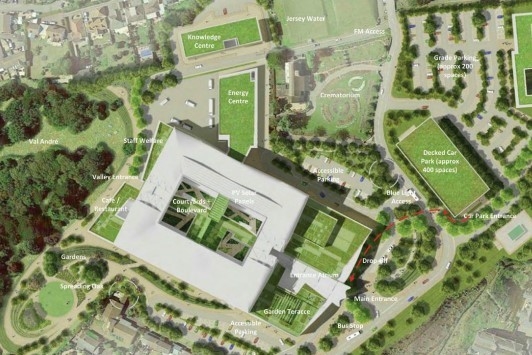SHARPLY contrasting views about the impact of the proposed new hospital at Overdale were aired during the second day of the public inquiry into the plans.
While an architect representing the project team compared the new facility to Fort Regent and said it could become an accepted landmark on the St Helier skyline, one of the government’s senior planners said the scheme would cause ‘irrevocable harm’.
At the end of the five-day inquiry, independent planning inspector Philip Staddon will compile a report, containing advice about whether the project should proceed. Environment Minister John Young will then make a final decision
Landscape architect Ruth Knight, of LDA Design, who said she had worked on the project for almost two years, showed a series of views of the proposed facility from a range of vantage points.
Miss Knight said that while the proposed building would be visible to the west of St Helier, it could potentially join sites such as Victoria College, Fort Regent and Almorah Crescent as a feature of the area. She said: ‘The proposed hospital could become another of those landmark features perched above the escarpment within this urban character area.’
Considerable work had been carried out to reduce the scale of the hospital, Miss Knight said, as well as to preserve the majority of the trees on the sloping land to the south and west. She said there were also plans to plant further trees to the east of the site, where many had already been lost as part of work to build apartments overlooking the People’s Park.
Miss Knight said that while the location of the hospital meant that it could be seen from a distant point such as Noirmont, this should not be seen entirely as a disadvantage, given ‘the excellent views of St Aubin’s Bay that would be available to recuperating patients’.
Chris Jones, a senior government planner with 40 years’ experience, said that while Overdale had been described as forming ‘a spectacular stage’ for the new hospital, the site was a challenging one.
He referred to planning policy stipulations that buildings on the top of the ridge line should be no more than 15 metres high, but said the hospital would be 27 to 32 metres in height.

He added: ‘The more prominent the site, the harder it is to integrate a new building into its setting.’
The overall benefit of the hospital did not outweigh the harmful impact, Mr Jones added, describing proposed mitigation measures as ‘welcome but insufficient’.
He said: ‘Such is the scale and mass of the building, including the adjacent car park and mental-heath unit, that it would cause irrevocable harm to the character of the area.
‘We understand the clinical need and how the design and impact has evolved, but just don’t think we are getting the best proposal we could for what is an extremely visible site and, as it stands, we can’t offer our support.’
Islander Michael De La Haye, a former States Greffier, offered Mr Staddon his view, which was that the design team had tried to fit too much into the building, which he likened to ‘putting a quart into a pint pot’.
Mr De La Haye blamed the government for the current situation, saying that ministers had pressed on regardless with the project after being warned about planners’ reservations, rather than seeking an alternative solution.
Mr Staddon highlighted the need to align different elements of the Bridging Island Plan, recently passed by the States Assembly, with one part referring to the need for a new hospital, while others covered the importance of not causing adverse impact to the views and the green backdrop.
When Mr Jones said that bringing together the different priorities included in the Bridging Island Plan was ‘extremely difficult’, Mr Staddon replied: ‘Yes, I know that.’






